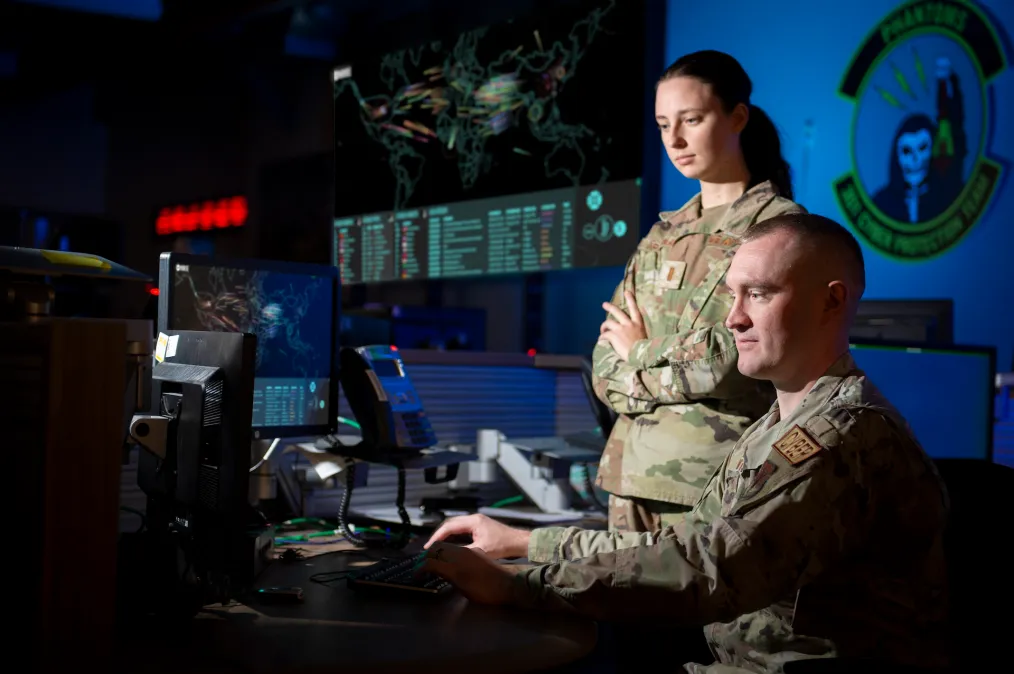Air Force splitting up intelligence and cyber effects organization

As part of the Air Force’s sweeping changes to be better organized to fight a sophisticated China threat, the service is splitting up its intelligence and cyber directorate on the Air Staff at the Pentagon.
Like the Navy, the Air Force years ago chose to integrate its intelligence function — known as the 2 — and its communications and network function, known as the 6, into the A2/6, led by a three-star general. It also added cyber to that portfolio, resulting in an official title of deputy chief of staff for intelligence, surveillance, reconnaissance and cyber effects operations.
Now, the service is dividing those functions to elevate the role of cyber and networks in a future conflict.
“The Chief of Staff of the Air Force needs a senior cyber officer to be his advisor. He can’t have a senior intelligence officer be that advisor,” Lt. Gen. Leah Lauderback, the A2/6, said Monday during a presentation at the annual DAFITC conference in Alabama. There should be a “three-star at the Air Staff who is advising the secretary of the Air Force, is advising the chief, is partnered with the [principal cyber adviser], partnered with the CIO, and we are well on our way to making that happen.”
While cyber was born out of the intelligence world and there are significant efficiencies between the two function — namely signals intelligence — the service feels it needs distinct separation between the two going forward.
Lauderback said the hope is to have a three-star confirmed by spring 2025 to establish this new A6. At that point, the A2 will go back to focus solely on intelligence, surveillance and reconnaissance matters.
She noted this is in line with Secretary Frank Kendall’s charge to elevate Air Forces Cyber as part of that reoptimization effort for great power competition. Details regarding that elevation remain vague, with top officials saying they want to take their time to ensure all the various equities are taken into account.
“Elevate AFCYBER. This goes along the same theme, as the secretary said when he thought that he needed an A6. The theme is: I need to elevate the 6 community, the cyber community,” Lauderback said. “It needs to be elevated so that it is on par with air superiority, with mobility superiority, with electromagnetic superiority, all of the other mission sets that we have in the service. I think that this elevation of both the 6 and then of AFCYBER is going to put this at the forefront of all of the senior leadership within the Department of the Air Force, so that they understand you can’t work without comms and you can’t work without cyber operations, attacking the enemy and defending from the enemy.”
The effort also appears to be part of a continued consolidation and emphasis on integrated information warfare capabilities. America’s adversaries have emphasized information warfare, a broad swath of related disciplines including cyber, electronic warfare, intelligence, communications and space, among others. They have prioritized these capabilities and organized to integrate them, making significant gains relative to U.S. forces.
Information warfare personnel could help deter actors such as China, according to officials.
“If 2027 is the planning date [for China to invade Taiwan], if we do IW correctly in the information environment and we’re able to deter the Chinese for something they are thinking about doing in 2027, maybe when 2027 rolls around there’s a recognition that it’s not the year to do it. Maybe [the Chinese will decide] ‘We’ll do it 2028, maybe we’ll do it 2029,’” Lt. Gen. Thomas Hensley, who took command of 16th Air Force less than three weeks ago, said at the same conference.
“16th Air Force, IW [numbered air force], we’re in the competition phase right now, where we’re doing things in multiple domains at a threshold below armed conflict to help shape that information environment so that we can deter the Chinese,” he added. “I think that’s the importance of engaging in the information environment with IW and using all the tools to be able to do that.”
However, the service still is not optimized for this fight.
“As the secretary has asked multiple times: Are we ready for a fight with China tonight? Clearly, he’s not comfortable with the answers that he’s getting, so that’s why we’re doing [great power competition] reoptimization, so that we get faster … and we need to do [that] to get ready for a fight with China,” Hensley said.
Hensley noted that the Air Force needs to invest in more information warfare personnel, known as 14Fs in Air Force personnel parlance. There are currently only about 200. Plans call for having around 500 eventually across the entire service.
“If we’re serious about making information warfare a domain where we want to make a difference, then we’ve got to increase the number of information warfare warriors in our military,” he said.
A recent report from the RAND Corp. highlighted some of the Air Force’ shortfalls, noting it has failed to realize its ultimate vision and much of the reforms made remain largely aspirational.
Other officials pointed to how the reoptimization efforts — and particularly the changes between the A2/6 — will help establish better structures for operations in the information environment.
For example, the electromagnetic spectrum operations team will move out of the 2 function and into the 3 function, which is focused on operations to combine with the cyber effects and information operations portions to create a new directorate focused on IW ops.






